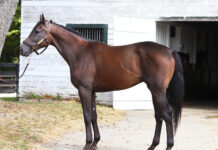 On May 18, I had the pleasure of attending Alltech’s 25th International Animal Health and Nutrition Symposium. The theme was “the sustainability principle.” Alltech, as you may know, researches and develops animal feed products for numerous industries (equine, cattle, pigs, poultry, aquaculture), and is also the title sponsor of the 2010 Alltech FEI World Equestrian Games to be held in Lexington, Ky.
On May 18, I had the pleasure of attending Alltech’s 25th International Animal Health and Nutrition Symposium. The theme was “the sustainability principle.” Alltech, as you may know, researches and develops animal feed products for numerous industries (equine, cattle, pigs, poultry, aquaculture), and is also the title sponsor of the 2010 Alltech FEI World Equestrian Games to be held in Lexington, Ky.
First up was Dr. Martin-Rosset from the Institute National de la Recherche Agronomique (INRA), France’s equivalent of our National Research Council (NRC). Martin-Rosset explained how the nutritive value of feed is evaluated differently in Europe versus the U.S. The INRA calculates caloric value of feed to the horse as “net energy,” a much more sophisticated measurement than “digestible energy,” which is what we are taught in classrooms and research papers stateside.
Next to go was Stephen Duren, Ph.D., from Performance Horse Nutrition in Idaho. Duren spoke about special needs equines, such as the old, obese, underweight, insulin-resistant and laminitis-prone. Some of these horses, such as the insulin-resistant, require a very carefully controlled low-starch diet. Low-starch does not mean low-fiber, however, so care must always be taken to feed any horse plenty of roughage.
Dr. Bridgette McIntosh from the University of Tennessee gave the next talk on carbohydrates vs. fats. McIntosh discussed use of energy-dense fat to beef up the calorie content of feed as opposed to starchy grains, which can trigger problems in some horses. Extremely low-starch diets are not required by most horses, though. Starch may actually be a necessary energy source for certain types of horses, such as those in short- and middle-distance race training.
Bill Schurg, Ph.D., of the University of Arizona spoke on the matter of confined horses. In the Southwest, where there is little grazing to be had and most horses live on dirt lots, confinement is a way of life as owners try their best to keep horses shaded from the blistering summer sun and heat. Schurg relayed an anecdote where he got a call that a bunch of horses had colicked on the same farm in the same week and the farm manager had no idea why. He came out and stuck a thermometer in their water trough: it read 126 degrees Fahrenheit, far too hot for horses to consume. Clearly, they had colicked from lack of hydration in their digestive tracts.
Catherine Dunnett from Independent Equine Nutrition in Suffolk, England, gave a talk entitled “Targeting phosphorus: Using solid state fermentation technologies to improve digestion and reduce inorganic P needs.” Much of the phosphorus in feed ingredients is “trapped” in the form of phytate and unavailable. To be sure your horse is meeting his phosphorus requirements, read feed bag labels or talk to an extension agent who specializes in equine nutrition.
Last to go was Bill Vandergrift, Ph.D., of EquiVision Inc. in Kentucky. He discussed cutting feeding costs without sacrificing quality. “Do I really need that?” is a question every horse owner should ask before adding vitamins, minerals, neutraceuticals, etc., to their horse’s ration. Does it increase longevity or decrease days lost in training due to injury? There are many factors horse owners want to maximize in their horses, but looking for some sort of proof is a good idea before adding more products.
The theme of the conference was an important one, as well. With so many animal nutritionists visiting from the world over, it was nice to see agreement on the need for feeding practices that can be sustained over the long haul.
Read more on balancing your horse’s diet.
Back to The Near Side.






Sounds like it was great